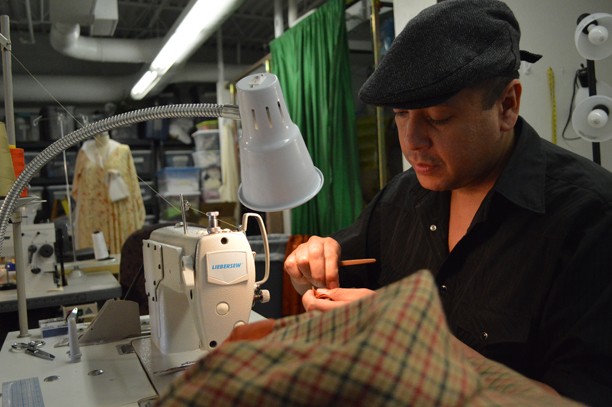Tucked away in the modern and lavish Stevie Eller Dance Theater, down a simple cement hallway and through a propped door, ordinary walls welcome visitors to the modest room that serves as a costume shop for the theater.
However, there’s nothing ordinary about this place.
“Well, it’s a theater setting, so you know everyone’s a little more relaxed than the average college worker,” said Jeremy M. Barney, the dance theater’s costume designer. “Open-minded’s the right word.”
The team, or family, as they view themselves, is currently working on garments for the Feb. 14 to March 3 Premium Blend series at the dance theater.
“It’s so much work, I mean what goes into building a costume, it’s a lot of your head, your brainwork,” said Pablo Rodarte, a shop technician.
Rodarte, has been whirling to flamenco and Spanish dance for more than 40 years, as he danced professionally before teaching at the University of New Mexico. He has been working in the UA shop for two seasons now.
“As a performer, I don’t think we have any idea of what goes behind the costumes that you’re wearing and what it takes to make them,” Rodarte said. “They call it building. It’s architecture.”
Costume shop top hand Marty Pavatea agreed that his past experiences made for a smooth transition.
“Being exposed to performers … they’re not normal people,” he added. “I don’t think a lot of us are normal either, so I think it kind of works.”
Each garment is tailor-made and fitted specifically for its wearer, as the team measures every dancer at the beginning of the year. The shop then uses high-quality fabrics and professional sewing techniques to make costumes, according to Barney.
“It’s a lot of work and it’s really hectic,” said Kristen Wheeler, costume shop supervisor.
After discussing with the choreographer, Barney sketches design concepts to fit their shared imagination. The “family” then designs, orders, creates mock-ups and adds corrections to fabrics and garments before crafting the finalized performance costumes.
Even then, choreographers don’t approve of some of the outfits, meaning the costume team is back to square one.
Wheeler, who’s worked in the shop for more than four years, said the shift from theater to dance costume design was “a little shocking.”
“In theater most plays will have eight characters and in dance it’s like, ‘Oh, you’re doing a show with eight pieces and each show has 52 characters,’” she added.
Though the scale of the operation surprised Wheeler, the transition from performing on-stage to working behind the scenes hasn’t knocked the family off-rhythm.
“It’s all connected, really,” Rodarte said. “We’re just on the other side. We’re not performing, we’re making, we’re producing.”








